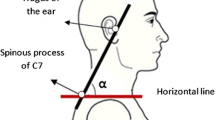Summary
A gamma-ray scanner has been used to develop in vivo a rapid, noninvasive technique for the estimation of the mass of successive body scans, and the positions of the centres of those masses. The integrated data are computed to calculate the mass supported by each vertebra and the coordinates of the centre of these masses. These coordinates are transfered from the coordinate system of the gamma ray table to the coordinate system of the X-ray radiographs. In this way, the anatomical relations of the centres of these masses are visualized on the frontal and sagittal full spine radiographs.
The method allowed the estimation of various biomechanical parameters such as the height of half the body mass or the compressive load on a specific vertebra. These new parameters were found to be similar to equivalent parameters in the literature. Therefore, these comparisons validate the method.
Fourteen normal subjects were tested, and their mean data are proposed as reference.
Résumé
Un scanner à rayon gamma balaie le tronc de haut en bas et évalue à chaque balayage la masse corporelle correspondante et les coordonnées de son point d'application. L'intégration permet de calculer la masse et le centre de masse du segment corporel supporté par chaque vertèbre. Ces coordonnées sont transposées du système de coordonnée de la table du scanner à rayon gamma dans le système de coordonnée d'un couple de radiographies face et profil du rachis en entier. Ainsi, les rapports anatomiques de ces centres de masse se trouvent visualisés sur les radiographies. Ces mesures, et leur représentation anatomique, permettent l'évaluation de certains paramètres biomécaniques, comme la hauteur de la moitié de masse corporelle qui coïncide avec le centre de gravité, ou la force de compression subie par une vertèbre de niveau spécifique. Les paramètres ainsi évalués confirment leur similitude avec les paramètres équivalents de la littérature; ceci représente une validation de la méthode. Quatorze sujets normaux ont subi cet examen, les valeurs moyennes sont proposées comme référence.
Similar content being viewed by others
References
Barter JT (1957) Estimation of the mass of body segments. WADC. Technical Wright Air Development Center. Wright Patterson Air Force Base, Ohio
Braune W, Fischer O (1892) Bestimmung der Trägheitsmomente des menschlichen Körpers und seiner Glieder. Abh Math-Phys Kl, Saechs Akad Wiss 18: 409
Duval-Beaupère G, Ovazza D, Tisseau J, Pascal A, Roche P, Csakvary E (1976) Mise au point d'un appareillage de mesure de la masse des segments corporels et de son point d'application. INSERM, Colloque de synthèse d'action thématique. 6: 165–177
Dempster WI (1955) Space requirements of the seated operator. WADC-TR 55-159. Wright Air Development Center. Wright Patterson A. F. Base, Ohio
Gagnon M, Monpetit R (1981) Technological development for the measurement of the center of volume in the human body. J Biomech 14: 235–241
Hellebrandt FA, Tepper RH, Braun GL, Elliot MC (1938) The location of the cardin anatomical orientation planes passing through the center of weight in young adult women. Am J Physiol 121: 465–470
King Liu Y, Montroe-Laborde J, Van Burskirk WC (1971) Inertial properties of a segmental cadaver trunk: their implication in acceleration injuries. Aerospacial Med 42: 650–657
Pascal A, Csakvary ET, Porte P (1974) Barycentremètre MCG10. Notice technique. CEASES/PUP/SERF pp 74–237
Schultz A, Anderson GJ, Ortengren R, Haderspezck K, Nachemson A (1982) Loads on the spine. Validation of a biomechanical analysis by measurements of intradiscal pressures and myoelectric signals. J Bone Joint Surg 64A: 713–720
White A, Panjabi M (1978) Functional spinal unit and mathematical models in clinical biomechanics of the spine. Lippincott Co, Philadelphia Toronto, pp 35–42
Author information
Authors and Affiliations
Rights and permissions
About this article
Cite this article
Duval-Beaupère, G., Robain, G. Visualization on full spine radiographs of the anatomical connections of the centres of the segmental body mass supported by each vertebra and measured in vivo. International Orthopaedics 11, 261–269 (1987). https://doi.org/10.1007/BF00271459
Issue Date:
DOI: https://doi.org/10.1007/BF00271459




